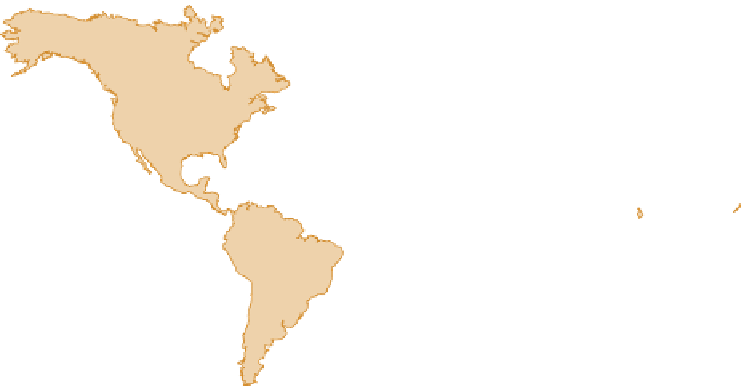Geoscience Reference
In-Depth Information
Oceans and Seas on Earth
Ocean was recognized because it encircles Antarctica and has
distinctive circulatory patterns.
We use the term
ocean
to refer to these large water bodies.
The terminology for smaller areas of water more closely asso-
ciated with land is inconsistently applied. In general, the next
largest bodies of water are considered to be
seas
, which are
subdivisions of oceans and partially enclosed by land. For ex-
ample, the Mediterranean Sea (Figure 19.1) is mostly surround-
ed by the European, Middle Eastern, and African landmasses.
In fact, it opens to the Atlantic only in its far western end.
After seas the next largest body of water is considered to
be a
gulf
, which is a smaller arm of an ocean or sea that is also
partially enclosed by land. Unfortunately, use of the terms
gulf
or
sea
can be misleading because some named gulfs are actu-
ally larger than some seas. The Gulf of Mexico, for example,
is much larger at 1.6 million km
2
(615,000 mi
2
) than the Black
Sea in Eastern Europe, which is 422,000 km
2
(163,000 mi
2
).
Before we begin discussing various coastal processes, let's
take a closer look at the character of the world's oceans and
seas because it provides the context in which to view the shore.
Figure 19.1 shows the names and locations of most of the no-
table large water bodies on Earth. The term
ocean
refers to the
enormous body of salty water that covers about 71% of Earth.
Five geographic divisions of the world's oceans are recognized.
The largest is the Pacific Ocean, which encompasses a third of
Earth's surface. This ocean is significantly larger than Earth's
entire landmass, having an area of 179.7 million km
2
(69.4 mil-
lion mi
2
). The next largest ocean is the Atlantic, followed by
the Indian Ocean, then the recently recognized (in 2000) South-
ern Ocean, and the Arctic Ocean. The Arctic Ocean covers an
area of about 14,090,000 km
2
(5,440,000 mi
2
), which is slightly
less than 1.5 times the size of the United States. The Southern
180°
150° W
120° W
90° W
60° W
30° W
0°
30° E
60° E
90° E
120° E
150° E
180°
ARCTIC OCEAN
ARCTIC OCEAN
Chukchi
Sea
Laptey Sea
East
Siberian Sea
Greenland
Sea
Norwegian
Sea
Kara Sea
Barents Sea
Baffin
Bay
Labrador
Sea
Beaufort Sea
Baltic
Sea
Bering Sea
Hudson
Bay
White
Sea
Black
Sea
Sea of
Okhotsk
Gulf of
St. Lawrence
60° N
60° N
North Sea
Persian
Gulf
Yellow
Sea
Sulu
Sea
Sea of
Japan
Gulf of
Alaska
Bay of
Biscay
Gulf of
Mexico
Bay of
Fundy
Sargasso
Sea
Arabian
Sea
East China
Sea
Gulf of
California
30° N
30° N
Mediterranean Sea
Red Sea
South
China
Sea
Caribbean
Sea
Banda
Sea
0°
0°
Gulf of
Guinea
Coral
Sea
INDIAN
OCEAN
Tasman
Sea
30° S
PACIFIC OCEAN
ATLANTIC OCEAN
30° S
Mozambique
Channel
Scotia Sea
60° S
60° S
SOUTHERN OCEAN
Weddell
Sea
Ross Sea
Ross Sea
0
3000 km
Figure 19.1 Global distribution of oceans, seas, and gulfs.
Five oceans are recognized on
Earth. The largest ocean is the Pacific, followed by the Atlantic, Indian, Southern, and Arctic. Seas
and gulfs are relatively small components of the oceanic network that are surrounded by land to a
considerable extent.
0
3000 mi
The entire body of salt water that covers about 71%
Ocean
A subdivision of an ocean that is partially enclosed by land.
Sea
of Earth.
Gulf
A relatively small body of salt water that is surrounded
by land on three sides and opens to a sea or ocean.




































































































































